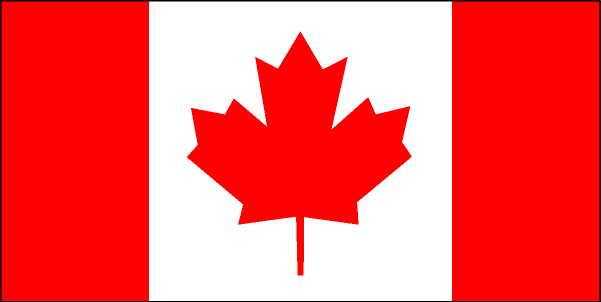
|

Canada
Background:
A land of vast distances and rich natural resources, Canada became a
self-governing dominion in 1867 while retaining ties to the British crown.
Economically and technologically the nation has developed in parallel with the
US, its neighbor to the south across an unfortified border. Its paramount
political problem continues to be the relationship of the province of Quebec.
Location:
Northern North America, bordering the North Atlantic Ocean on the
east, North Pacific Ocean on the west, and the Arctic Ocean on the north, north
of the conterminous US.
Area: Total: 9,976,140 sq km, land: 9,220,970 sq km, water: 755,170 sq km.
Area - comparative: Slightly larger than the US
Land boundaries: Total: 8,893 km border countries: US 8,893 km (includes 2,477
km with Alaska).
Coastline: 243,791 km.
Return to Visiting Locations
|
|
People:
Population: 31,902,268.
Ethnic groups: British Isles origin 28%, French origin 23%, other European 15%,
Amerindian 2%, other, mostly Asian, African, Arab 6%, mixed background 26%.
Religions: Roman Catholic 46%, Protestant 36%, other 18%.
Languages: English 59.3% (official), French 23.2% (official), other 17.5%.
Climate and Terrain:
Climate: Varies from temperate in south to sub arctic and arctic in north.
Terrain: Mostly plains with mountains in west and lowlands in southeast.
Elevation extremes: Lowest point: Atlantic Ocean 0 m, highest point: Mount
Logan 5,959 m.
Natural resources: Iron ore, nickel, zinc, copper, gold, lead, molybdenum,
potash, silver, fish, timber, wildlife, coal, petroleum, natural gas,
hydropower.
Government:
Government type: Confederation with parliamentary democracy.
Capital: Ottawa.
Independence: 1 July 1867 (from UK).
Economy overview:
As an affluent, high-tech industrial society, Canada today closely resembles
the US in its market-oriented economic system, pattern of production, and high
living standards. Since World War II, the impressive growth of the
manufacturing, mining, and service sectors has transformed the nation from a
largely rural economy into one primarily industrial and urban. The 1989
US-Canada Free Trade Agreement (FTA) and 1994 North American Free Trade
Agreement (NAFTA) (which includes Mexico) touched off a dramatic increase in
trade and economic integration with the US. As a result of the close
cross-border relationship, the economic downturn in the United States in 2001
had a negative impact on the Canadian economy. Real growth averaged nearly 3%
during 1993-2000, but declined in 2001. Another long-term
concern is the flow south to the US of professionals lured by higher pay, lower
taxes, and the immense high-tech infrastructure.
GDP - composition by sector: Agriculture: 2%, industry: 29%, services: 69%.
Statistics:
Telephones - main lines in use: 18.5 million.
Telephones - mobile cellular: 4.207 million.
Radio broadcast stations: AM 535, FM 53.
Radios: 32.3 million.
Television broadcast stations: 80.
Televisions: 21.5 million.
Internet users: 14.44 million.
Railways: Total: 36,114 km .
Highways: Total: 901,902 km, paved: 318,371 km. unpaved: 583,531 km.
Airports: 1,419, with paved runways: 519, with unpaved runways: 900.
Heliports: 18.
|

